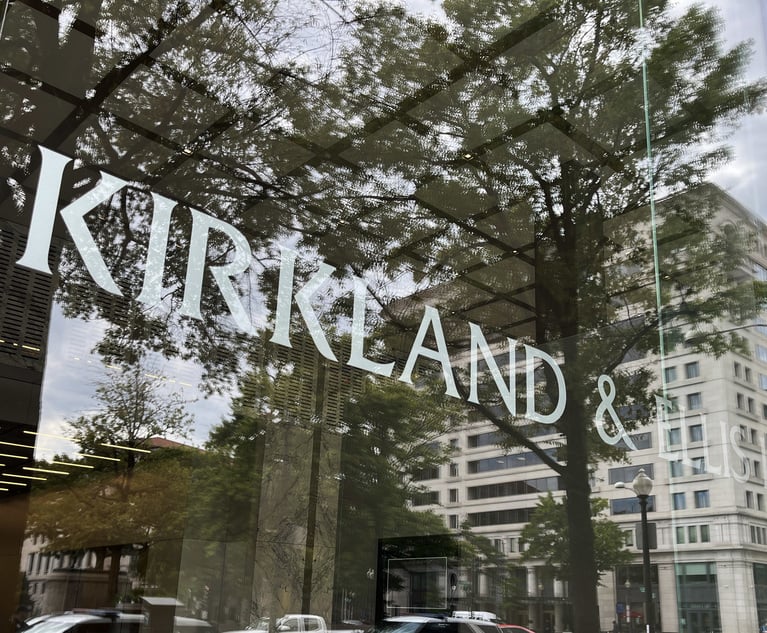Trick Question: How Do You Classify a Gig Worker?
The gig economy presents complex employment issues that are resulting in inconsistent legal rulings on the independent contractor or employee status…
November 02, 2017 at 06:35 PM
5 minute read

The gig economy presents complex employment issues that are resulting in inconsistent legal rulings on the independent contractor or employee status of gigging workers. This has left companies uncertain about how to run their businesses and classify their workforces.
In the gig economy, providers are technology companies with software platforms for users to connect with service providers. The technology company provides leads and payment processing services to the service provider, who is able to use multiple apps and accept or decline leads provided by the company. Service providers typically use their own equipment, such as tools or vehicles, to perform the services. Currently 20 percent to 30 percent of the workforce in the United States engages in some “gigging” work. See “Independent Work: Choice, Necessity, and the Gig Economy,” McKinsey Global Institute, October 2016.
So, how does the law classify these gigging workers? We could ask perhaps the largest gig economy company, Uber, but even it could not tell us. Uber, alone, has gotten inconsistent answers to this question from tribunals across the country.
In 2015, the California labor commissioner found that Uber drivers are employees. Berwick v. Uber Technologies, Case No. CGC-15-546378, Superior Court of California. Yet in 2017, a private arbitrator found California Uber drivers are independent contractors. Uber Technologies v. Y.E., Case No. BS 166561, Superior Court of California. A Florida appeals court agreed, finding Uber drivers are independent contractors. McGillis v. Rasier d/b/a Uber, 210 So.3d 220 (3d Dist., 2017).
These divergent outcomes are partially caused by multiple tests under various laws—tests developed decades ago, before the iPhone and its apps. The National Labor Relations Act, which allows only employees to be organized by unions, applies a common-law agency test that focuses on the amount of control by the putative employer and whether the worker resembles an independent business with its own economic risk. Decisions under the Fair Labor Standards Act are evaluated under the Economic Realities Test, which evaluates whether there is an entrepreneurial opportunity for loss or gain by the worker.
There are also state-specific legal standards applied by courts in evaluating independent contractor status, and those standards vary widely. In California, the test is essentially whether someone performs a service for a company or individual, in which case the person performing the service is presumed to be an employee. Lyft v. Cotter, 60 F. Supp. 3d 1067, 1073-74 (N.D.C.A. 2015). A pending California gig economy case is Larson v. GrubHub, Case No. 15-CV-05128 (N.D. CA), which began a bench trial in September. The court in GrubHub has focused on the right to control by the service provider throughout the case. We should know more toward the end of the year on how the court will rule in GrubHub, and whether the parties will take the matter to the Ninth Circuit. It is unlikely that this case will go to the U.S. Supreme Court because the court is determining only California law.
In contrast to California, Texas directly addressed the gig economy classification issue through legislation. In May, Texas passed House Bill 100, which applies to transportation services, such as Uber or Lyft. It says any driver working for a transportation network company (TNC) is properly classified as an independent contractor if four requirements are met. First, the TNC cannot control the drivers' hours. Second, the TNC must permit drivers to work for other ride-hailing services if they please. Third, the TNC must allow drivers to engage in any other occupation or business they desire. Fourth, the TNC cannot limit the territory within which the driver may provide rides. Because these are fairly standard elements in any gig economy relationship, the law provides a legislative basis for businesses across Texas to properly classify any gig worker as an independent contractor.
The judge in Uber's recent Florida case stated, “we must decide whether a multi-faceted product of new technology should be fixed into either the old square hole or the old round hole of existing legal categories, when neither is a perfect fit.” McGillis, 210 So.3d at 223-24. The legislative move made in Texas earlier this year represents an effort to fix the “square peg/round hole” gig economy dilemma and comes in stark contrast to the legal landscape in California. It is likely that other states will begin implementing legislative solutions for the gig economy, too.
In the meantime, how are multistate gig economy companies supposed to classify their workers? The short answer is: no one knows. Even in employer-friendly states such as Texas with state legislation addressing the issue, cases under the FLSA or NLRA will apply federal standards and pre-empt state law. And, unfortunately, we are unlikely to get any guidance from the U.S. Supreme Court on these issues soon, as there are no test cases close to making their way to the high court.
To avoid litigation, gig economy companies could classify their workers as employees. However, this likely would not fit their business models and would come with tremendous expense. Gig economy companies would be wise to examine their business practices to determine if there is a way to exert less control over their gigging workers in response to the varied legal decisions across the country. For now, though, we will have to wait and see how these issues pan out.
Thomas L. Case and Alana K. Ackels are partners at Bell Nunnally & Martin in Dallas. They can be reached at [email protected] and [email protected], respectively, or via the firm's website: www.bellnunnally.com.
This content has been archived. It is available through our partners, LexisNexis® and Bloomberg Law.
To view this content, please continue to their sites.
Not a Lexis Subscriber?
Subscribe Now
Not a Bloomberg Law Subscriber?
Subscribe Now
NOT FOR REPRINT
© 2025 ALM Global, LLC, All Rights Reserved. Request academic re-use from www.copyright.com. All other uses, submit a request to [email protected]. For more information visit Asset & Logo Licensing.
You Might Like
View All
Law Firms Are 'Struggling' With Partner Pay Segmentation, as Top Rainmakers Bring In More Revenue
5 minute read


Kirkland Is Entering a New Market. Will Its Rates Get a Warm Welcome?
5 minute readTrending Stories
- 1Uber Files RICO Suit Against Plaintiff-Side Firms Alleging Fraudulent Injury Claims
- 2The Law Firm Disrupted: Scrutinizing the Elephant More Than the Mouse
- 3Inherent Diminished Value Damages Unavailable to 3rd-Party Claimants, Court Says
- 4Pa. Defense Firm Sued by Client Over Ex-Eagles Player's $43.5M Med Mal Win
- 5Losses Mount at Morris Manning, but Departing Ex-Chair Stays Bullish About His Old Firm's Future
Who Got The Work
J. Brugh Lower of Gibbons has entered an appearance for industrial equipment supplier Devco Corporation in a pending trademark infringement lawsuit. The suit, accusing the defendant of selling knock-off Graco products, was filed Dec. 18 in New Jersey District Court by Rivkin Radler on behalf of Graco Inc. and Graco Minnesota. The case, assigned to U.S. District Judge Zahid N. Quraishi, is 3:24-cv-11294, Graco Inc. et al v. Devco Corporation.
Who Got The Work
Rebecca Maller-Stein and Kent A. Yalowitz of Arnold & Porter Kaye Scholer have entered their appearances for Hanaco Venture Capital and its executives, Lior Prosor and David Frankel, in a pending securities lawsuit. The action, filed on Dec. 24 in New York Southern District Court by Zell, Aron & Co. on behalf of Goldeneye Advisors, accuses the defendants of negligently and fraudulently managing the plaintiff's $1 million investment. The case, assigned to U.S. District Judge Vernon S. Broderick, is 1:24-cv-09918, Goldeneye Advisors, LLC v. Hanaco Venture Capital, Ltd. et al.
Who Got The Work
Attorneys from A&O Shearman has stepped in as defense counsel for Toronto-Dominion Bank and other defendants in a pending securities class action. The suit, filed Dec. 11 in New York Southern District Court by Bleichmar Fonti & Auld, accuses the defendants of concealing the bank's 'pervasive' deficiencies in regards to its compliance with the Bank Secrecy Act and the quality of its anti-money laundering controls. The case, assigned to U.S. District Judge Arun Subramanian, is 1:24-cv-09445, Gonzalez v. The Toronto-Dominion Bank et al.
Who Got The Work
Crown Castle International, a Pennsylvania company providing shared communications infrastructure, has turned to Luke D. Wolf of Gordon Rees Scully Mansukhani to fend off a pending breach-of-contract lawsuit. The court action, filed Nov. 25 in Michigan Eastern District Court by Hooper Hathaway PC on behalf of The Town Residences LLC, accuses Crown Castle of failing to transfer approximately $30,000 in utility payments from T-Mobile in breach of a roof-top lease and assignment agreement. The case, assigned to U.S. District Judge Susan K. Declercq, is 2:24-cv-13131, The Town Residences LLC v. T-Mobile US, Inc. et al.
Who Got The Work
Wilfred P. Coronato and Daniel M. Schwartz of McCarter & English have stepped in as defense counsel to Electrolux Home Products Inc. in a pending product liability lawsuit. The court action, filed Nov. 26 in New York Eastern District Court by Poulos Lopiccolo PC and Nagel Rice LLP on behalf of David Stern, alleges that the defendant's refrigerators’ drawers and shelving repeatedly break and fall apart within months after purchase. The case, assigned to U.S. District Judge Joan M. Azrack, is 2:24-cv-08204, Stern v. Electrolux Home Products, Inc.
Featured Firms
Law Offices of Gary Martin Hays & Associates, P.C.
(470) 294-1674
Law Offices of Mark E. Salomone
(857) 444-6468
Smith & Hassler
(713) 739-1250






